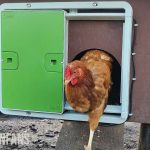Dominique Chicken: America’s Oldest Breed

Introducing the legendary Dominique breed, also known as Pilgrim Fowl and Dominicker. Prepare to embark on a journey explaining everything you need to know about the oldest recorded chicken breed in the United States. They not only have a fascinating history but are also a great choice for beginning chicken keepers!
- Dominique hens lay up to 4 to 5 eggs weekly
- Heritage breed, considered the oldest breed in the US
- Friendly nature but assertive
- Striking barred plumage resembling the Barred Plymouth Rock
| Eggs | Up to 240 eggs/year |
| Egg Color | Brown |
| Egg Size | Large |
| Weight | 5 – 7 lbs |
| Hardiness | Cold & Heat |
| Temperament | Friendly but assertive |
| Beginner-friendly | Yes |
| Color | Barred black and white |
Characteristics
Dominiques are often confused with Plymouth Rocks due to their many similarities, like a straight comb and barred markings. Interestingly, Plymouth Rocks were created by crossing a Dominique with another chicken breed. To tell them apart, you need to look closer at their combs and barring.
Plymouth Rocks have a singular upright comb, while Dominiques have a flatter rose comb with a singular backward spike, making it look like a flower. Hence the name rose comb. A Barred Plymouth Rock should have a very defined barring pattern. The Dominique has a more fuzzy pattern.
Dominique chickens and Barred Plymouth Rock chickens are also often confused with the Malines, another well-known chicken breed carrying the cuckoo pattern.
On the other hand, Dominiques have a softer contrast to their barring and have more of a staggered design. Breeders often refer to this as hawk coloration or cuckoo pattern.
Besides those characteristics, Dominiques also have bright red combs, earlobes, and wattles while having a yellow beak. Their legs and feet are also yellow.

When it comes to their size, Dominiques are a medium-sized breed. The male average is around 7 lbs (3 kg), while the female average is 4 lbs (2.4 kg).
Dominiques also have a bantam version, which the American Poultry Association first included in the 1960s. The males tip the scales at 28 oz (800 g), while the females weigh in at 26 oz (750 g).
Breed Profile and History
The Dominique breed has been around for almost 300 years and is widely considered the oldest poultry breed in America. It’s so old that there were no poultry standards back then, and the United States was not yet even a country.
And yet, there are no historical records as to the origins of this particular bird. Most people believe that British colonists brought birds that are similar to modern British breeds, like the Dorking and the Sussex, to America.
From there, the bird started to spread and grow in popularity, interacting with other breeds of that time to become what it is today. The name Pilgrim Fowl, one of the Dominique breed’s many names, is a nod to that point in history.
Another popular theory is that the breed came from a French colony of that period, Saint-Domingue, now Haiti. Hence the present-day name of these birds, Dominique. Besides those two prominent names, the breed was also known as the Blue Spotted Hen, Old Grey Hen, and Dominicker, to name a few.

In the early 1800s, many breeders were raising these birds on their farms due to their ability to produce eggs, offer meat, and give feathers for pillows and mattresses at the time. When the 1840s rolled around, the Dominique breed had become the most popular farmyard bird at the time and even appeared at America’s first-ever poultry show in 1849 in Boston.
Standardization
By the late 1860s, breeders had started crossbreeding this bird with other breeds from that period. One of those was the Black Java, and this union gave rise to the Plymouth Rock breed we see today.
And at the turn of the decade, organizers started standardizing the breed. Before that, the Dominique breed sports either a single comb or a rose comb.
But due to the appearance of Plymouth Rock, there needed to be a distinction between the two breeds. From then on, Dominiques were classified as having a rose comb and Plymouth Rocks as having a single comb.
This classification later became the first edition of the American Standard of Perfection, released by the newly established American Poultry Association (APA) in 1874. However, this also reduced the number of Dominiques at the time because those with single combs were far more numerous, thereby creating a serious dilemma for the breed down the line.
Dominique vs Barred Rock
At first sight, Dominique chickens and Barred Plymouth Rocks seem like identical twins. It’s easy to get a little mixed up when you’re trying to tell them apart. They both showcase a striking striped feather pattern, but there are subtle yet significant differences between these two American breeds.
Pattern: While both breeds have striped plumage, the pattern itself is different. Barred Plymouth Rocks have wide, evenly spaced black and white stripes. Dominique chickens, conversely, have a more irregular, “tiger stripe” pattern with thinner, often less-defined bars.

Comb: Plymouth Rocks have a single comb, while Dominique chickens have a flatter, less pronounced rose comb.
Size: Barred Plymouth Rocks are larger than Dominiques. While size alone may not always be a reliable indicator, if you have both breeds side by side, you will notice the difference.
Decline and Status
Dominiques remained popular up until the 1920s due to enthusiasts and breeders at the time. However, with each passing day, Plymouth Rocks are becoming the better choice because of how commercially viable they are as opposed to Dominiques.
Once interest in the breed started dying out, their numbers dropped drastically. If not for their hardiness and low upkeep, this breed could have died out during the Great Depression and World War II.
However, the breed faced extinction once again as farmers and breeders in post-war industrialization opted to use White Leghorns and other breeds that yielded more eggs and meat. This further increased the already rapid decline of the Dominique breed.
In the 1970s, there were only four known breed flocks available, with the total population amounting to a meager 500 birds. The Dominique breed would cease to exist if not for the cooperation of the four men who own those four flocks and the American Livestock Breeds Conservancy (ALBC, aka The Livestock Conservancy).
These four men were Henry Miller, Edward Uber, Robert Henderson, and Carl Gallaher. With their combined efforts with the ALBC of the time, they managed to maintain the purity of the breed and save many old bloodlines, including one that has been around for almost a hundred years.
In 1973, the Dominique Club of America was created to help further promote the breed and encourage beginners to take a liking to this chicken. Since then, the breed has started to recover steadily over the next decades.
As of 2021, the Livestock Conservancy declared the breed stable. And in the following year, the Domestic Animal Diversity Information System (DAD-IS) declared the breed not at risk.
Personality
Dominiques are friendly and docile birds that get along easily and well with children. Because of their calm demeanor, they also make great backyard pets. However, they can sometimes turn dominant toward other breeds if picked on.
They will often crowd around you, asking for treats, when you’re in the backyard with them. Even the chicks will follow you around, so be careful when taking a step.
The only time roosters may show any signs of aggression is during mating season. But they show no signs of it toward their caretakers.
Additionally, they are great foragers. When allowed to roam, they can survive mainly on the bugs and worms they find, saving you plenty of money for their feed. They do need, however, a constant supply of quality feed to keep them happy and healthy.
They also do well in confinement. On top of that, they don’t produce a lot of noise. This makes raising them in suburban areas viable, as you don’t need to worry about them waking up the neighbors or you.
Hardiness
Dominiques have feathers that are closely knitted to one another, allowing them to handle the cold weather easily. Historically, these feathers have worked great as filling material for the pillows and mattresses of their owners.
They can also handle hot and humid temperatures fairly well. But just like most breeds, you need to provide plenty of water and shade so they won’t get dehydrated.
The fact that these chickens don’t need much extra care besides food, water, and shelter and are very hardy makes them an excellent breed for beginning chicken keepers.
Egg Production
Dominiques are fairly good egg layers when it comes to laying eggs, as their egg production is nothing to scoff at. They can lay around four to five large eggs per week and up to 240 eggs yearly.
While their egg production pales compared to other egg layers, like the White Leghorn, they can continue to lay eggs throughout winter. This helps provide them with a certain edge when it comes to other breeds.

They usually start laying around five to six months old and produce medium-sized brown eggs. But as the hen grows bigger, so do the eggs.
Dominique hens are not particularly broody, although it does sometimes happen. And they are great mothers to their chicks, often raising and protecting them from harm.
Meat Production
Dominiques have good-quality meat that is edible and fairly tasty. They can provide a good amount of profit if you have plenty of them in bulk.
Otherwise, many people don’t see the appeal of raising them for their meat. That’s because they don’t provide the most meat for a dual-purpose bird. However, they are still large enough to provide your family with a hefty meal at the dinner table.
Summary
Dominiques still have a relatively low population despite the success of different breeding programs over the years. As such, consider picking up and taking care of this wonderful bird, especially if you’re just starting.
As mentioned throughout the article, they require very little maintenance and upkeep while providing you with plenty of company throughout the day. They also produce plenty of eggs and meat for you and your family.
If you want to add a new member to your flock or want to experience what it feels like to become a chicken owner, then the Dominique breed is worth checking out. With its rich history and calm demeanor, this bird is an exceptional start for anyone.
To learn more about chicken breeds, check out our ‘Chicken Breeds Page‘ to see every specific breed we address. Or go to our listicle breed summary on ‘The Classroom‘, or, if you’re unsure where to start, take a look at our ‘Chicken Breeds: Ultimate Beginners Guide‘.






















